Topic 1: Ch 7 Nursing Process and Standards of Care
mental status exam (MSE)
psychosocial assessment
physical examination
history taking
interviews
standardized rating scales
what does assessment of the BH client include
Home environment: relations with parents and siblings
Education and employment: school performance
Activities: sports, after-school activities, peer relations
Drug, alcohol, or tobacco use
Sexuality: sexually active, practices safe sex, uses contraception
Suicide risk or symptoms of depression/other mental disorder
Safety: how safe the patients feels at home/school, wear a safety belt, engage in dangerous/risky activities
what is the HEADSSS Psychosocial Interview technique
1/46
There's no tags or description
Looks like no tags are added yet.
Name | Mastery | Learn | Test | Matching | Spaced |
|---|
No study sessions yet.
47 Terms
mental status exam (MSE)
psychosocial assessment
physical examination
history taking
interviews
standardized rating scales
what does assessment of the BH client include
Home environment: relations with parents and siblings
Education and employment: school performance
Activities: sports, after-school activities, peer relations
Drug, alcohol, or tobacco use
Sexuality: sexually active, practices safe sex, uses contraception
Suicide risk or symptoms of depression/other mental disorder
Safety: how safe the patients feels at home/school, wear a safety belt, engage in dangerous/risky activities
what is the HEADSSS Psychosocial Interview technique
establish rapport
obtain an understanding of the current problem/chief complaint
review the patient’s physical status/obtain baseline VS
assess for RF affecting the safety of the paitent/others
Perform a MSE
assess psychosocial status
identify mutual goals for treatment
formulate a plan of care
document data in a retrievable format
what is the purpose of the psychiatric mental health nursing assessment
mental status exam (MSE)
aids in collecting objective information and is fundamental to the psychiatric-mental health nursing assessment
psychosocial assessment
provides additional information from which to develop a plan of care that begins with asking the patient to describe how treatment became necessary
stroke
Alzheimer’s
Brain tumor
Huntington’s
Epilepsy
MS
Parkinson’s
which neurological disorders are associated with depression
Mononucleosis
Encephalitis
Neurosyphilis
HIV
which infections are associated with depression
hypo/hyperthyroidism
Cushing’s
Addison’s
Parathyroid disease
which endocrine disorders are associated with depression
liver cirrhosis
pancreatitis
which GI disorders are associated with depression
hypoxia
CHF
which CV disorders are associated with depression
sleep apnea
which respiratory disorders are associated with depression
thiamine
protein
B12
B6
Folate
what nutritional deficiencies are associated with depression
lupus
rheumatoid arthritis
what collagen vascular disorders are associated with depression
Alzheimer’s
Brain tumor
Stroke
Huntington’s
which neurological disorders are associated with anxiety
encephalitis
meningitis
neurosyphilis
septicemia
which infections are associated with anxiety
hypo/hyperthyroidism
hypoparathyroidism
hypoglycemia
pheochromocytoma
carcinoid
which endocrine disorders are associated with anxiety
low calcium
low potassium
acute intermittent porphyria
liver failure
which metabolic disorders are associated with anxiety
angina
CHF
pulmonary embolus
which CV disorders are associated with anxiety
pneumothorax
acute asthma
emphysema
which respiratory disorders are associated with anxiety
stimulants
sedatives (withdrawal)
lead, mercury poisoning
which drug effects are associated with anxiety
temporal lobe epilepsy
migraines
temporal arteritis
occipital tumors
narcolepsy
encephalitis
hypothyroidism
Addison’s
HIV
which medical conditions are associated with psychosis
hallucinogens (LSD)
phencyclidine
alcohol withdrawal
stimulants
cocaine
corticosteroids
which drug effects are associated with psychosis
grooming/dress
levels of hygiene
pupil dilation/constriction
facial expression
height, weight, nutritional status
presence of body piercing or tattoos, scars, etc
relationship between appearance and age
what should the nurse include when assessing appearance in a MSE
excessive/reduced body movements
peculiar body movements (scanning of the room, odd/repetitive gestures, LOC, balance, gait)
abnormal movements (tardive dyskinesia, tremors)
level of eye contact (with cultural differences in mind)
what should the nurse include when assessing behavior in a MSE
rate: slow, rapid, or normal
volume: loud, soft, or normal
disturbances: articulation problems, slurring, stuttering, mumbling
what should the nurse include when assessing speech in a MSE
affect: flat, bland, animated, angry, withdrawn, appropriate to context
sade, labile, euphoric
what should the nurse include when assessing mood in a MSE
thought process: disorganized, flight of ideas, neologisms, thought blocking, circumstantiality
thought content: delusions, obsessions
what should the nurse include when assessing disorders of the form of thought in a MSE
hallucinations: auditory, visual
illusion
what should the nurse include when assessing perceptual disturbances in a MSE
orientation: time, place, and person
LOC: alert, confusion, clouded, stuporous, unconscious, comatose
memory: remote, recent, immediate
fund of knowledge
attention: performance on serial sevens, digit span tests
abstraction: performance on tests involving similarities, proverbs
insight
judgement
what should the nurse include when assessing cognition in a MSE
suicidal or homicidal history and current thoughts
presence of a plan
means to carry out the plan
opportunity to carry out the plan
what should the nurse include when assessing ideas of harming self/others in a MSE
psychosocial assessment
includes:
previous hospitalizations
educational background
occupational background
employed, where, what length of time
special skills
social patterns
describe family friends, household members, support system, and a typical day
sexual patterns
sexually active, practices safe sex/birth control
sexual orientation
sexual difficulties
interests
how do you spend spare time
interest in sports, hobbies, or leisure activities
what gives patient pleasure
substance use
what prescribed medications, how often, how much
any herbal or OTC meds, how often, how much
how many alcoholic beverages and what time per day/week
what recreational drugs, how often, how much
misuse prescription durgs
use drugs as a problem
coping abilities
what to you do when upeset
who do you talk to
what helps relieve stress
spiritual assessment
health behaviors
MDD
these standardized rating scales are used for what
Beck inventory
Brief PHQ
Geriatric Depression Scale (GDS)
Hamilton Depression Scale
Zung Self Report Inventory
PHQ-9
PHQ-A
anxiety
these standardized rating scales are used for what
Brief PHQ
Generalized Anxiety Disorder-7 (GAD-7)
Modified Spielberger State Anxiety Scale
Hamilton Anxiety Scale
Severity Measure for Generalized Anxiety Disorder Child (11-17)
trauma
adverse childhood experiences questionnaire
brief trauma questionnaire
PTSD Scale for SDM-5 (CAPS-5)
PTSD Symptom Scale Interview (PSS-I and PSS I-5)
long term goals/outcomes for a suicidal patient
patient will remain free from injury throughout the hospital stay
by discharge, patient will express hope and a desire to live and identify at least two people to contact if suicidal thoughts arise
short term goals/outcomes for a suicidal patient
patient will identify the rationale and procedure of the unit’s protocol for suicide precautions shortly after admission
patient will seek out staff when feeling overwhelmed or self-destructive duriing hospitalization
patients will meet with social worker to find supportive resources in the community before discharge and work on trigger issues
by discharge, patient will state the purpose of medication, time and dose, adverse effects, and whom to call for questions or concerns
patient will have the written anem and telephone numbers of at least two people to turn to if feeling overwhelmed or self destructive
patient will have a follow up appointment to meet with a mental health professional by discharge
a, e
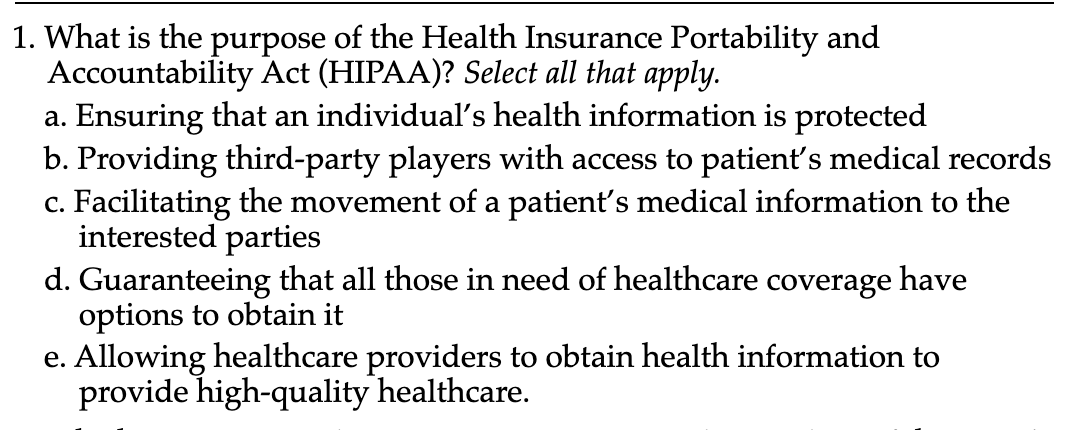
c

a, b, d, e
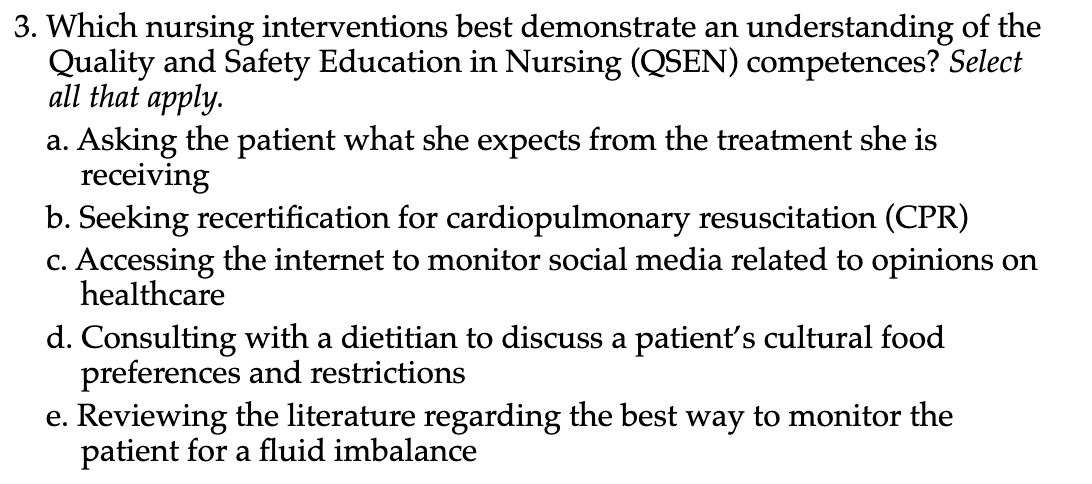
c

d

d

b
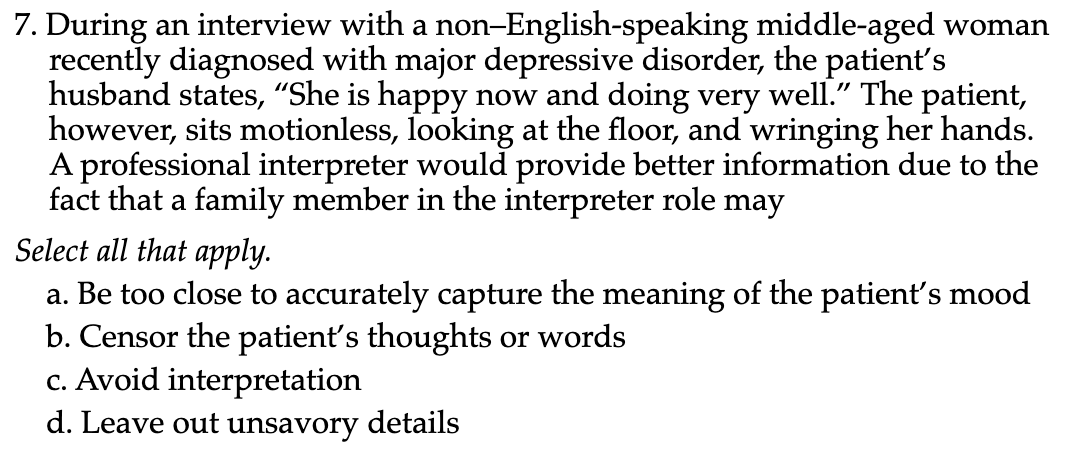
a
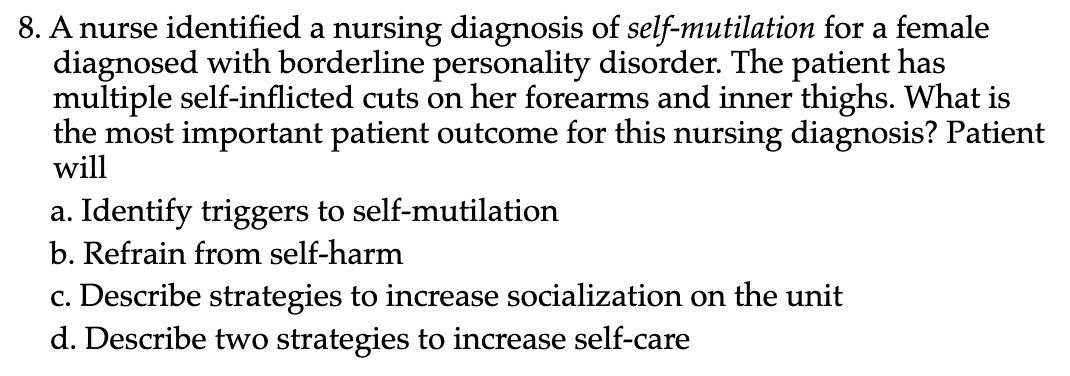
b
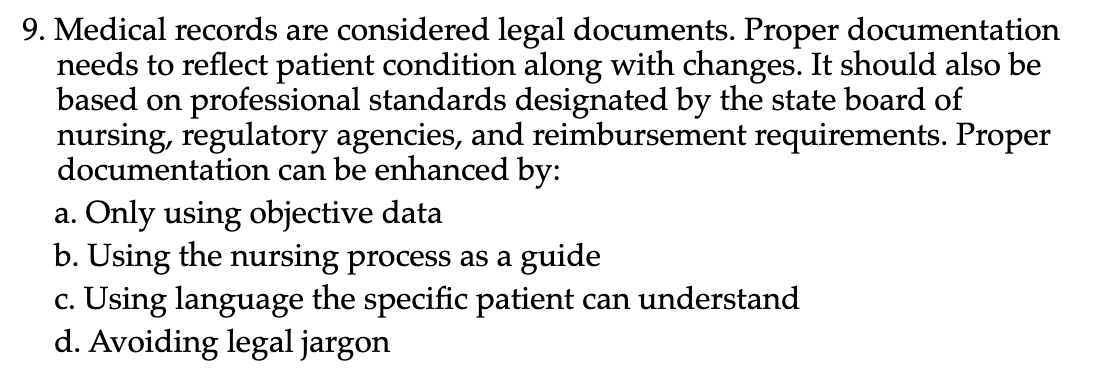
a, b, d
